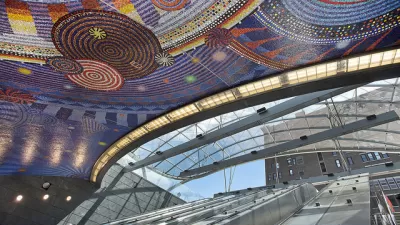Details are now just emerging about a proposal from NYC Mayor Bloomberg to further extend the IRT #7 line from the West Side station by a planned, massive new development, Hudson Yards. Cheaper than a commuter rail tunnel, it would serve NJ Transit.
The $9 billion plan to build a new set of rail tunnels under the Hudson River from NJ to NYC, known as Access to the Region's Core (ARC), came to an abrupt halt Oct. 27 when NJ Gov. Chris Christie pulled the plug on account of his concern that his state would be responsible for what he projected to be massive cost overruns.
"The NYC plan envisions the No. 7 stretching from 34th Street on the Far West Side of Manhattan to Secaucus, N.J., where there is a connection to New Jersey Transit trains.
It would do so at about half the cost, an estimated $5.3 billion, according to a closely guarded, four-page memorandum circulated by the city's Hudson Yards Development Corporation. And the project would almost certainly serve as a boon for the planned $15 billion Hudson Yards residential and office development, to be built on platforms over the West Side railyards."
No word from DOT Secretary Ray LaHood on the project proposal, perhaps that's because he's busy "wrangling with New Jersey to repay $271 million the federal government has spent on the project."
From Hudson Yards Development Corporation website:"Key components of the development program (include) the extension of the No. 7 subway line from its current terminus at Times Square to a new terminal station at 34th Street and 11th Avenue."
If the project is clearly viable as opposed to a trial balloon, it would also have to compete with a possible Amtrak proposal, which might be viewed more favorably by both Secretary LaHood as it would be high speed rail- capable, and the incoming presumptive chair of the House Transportation and Infrastructure Committee, John Mica (R-FL).
Thanks to Kenyon Karl
FULL STORY: Take the No. 7 to Secaucus? That’s a Plan

Planetizen Federal Action Tracker
A weekly monitor of how Trump’s orders and actions are impacting planners and planning in America.

Restaurant Patios Were a Pandemic Win — Why Were They so Hard to Keep?
Social distancing requirements and changes in travel patterns prompted cities to pilot new uses for street and sidewalk space. Then it got complicated.

Map: Where Senate Republicans Want to Sell Your Public Lands
For public land advocates, the Senate Republicans’ proposal to sell millions of acres of public land in the West is “the biggest fight of their careers.”

Maui's Vacation Rental Debate Turns Ugly
Verbal attacks, misinformation campaigns and fistfights plague a high-stakes debate to convert thousands of vacation rentals into long-term housing.

San Francisco Suspends Traffic Calming Amidst Record Deaths
Citing “a challenging fiscal landscape,” the city will cease the program on the heels of 42 traffic deaths, including 24 pedestrians.

California Homeless Arrests, Citations Spike After Ruling
An investigation reveals that anti-homeless actions increased up to 500% after Grants Pass v. Johnson — even in cities claiming no policy change.
Urban Design for Planners 1: Software Tools
This six-course series explores essential urban design concepts using open source software and equips planners with the tools they need to participate fully in the urban design process.
Planning for Universal Design
Learn the tools for implementing Universal Design in planning regulations.
Heyer Gruel & Associates PA
JM Goldson LLC
Custer County Colorado
City of Camden Redevelopment Agency
City of Astoria
Transportation Research & Education Center (TREC) at Portland State University
Camden Redevelopment Agency
City of Claremont
Municipality of Princeton (NJ)




























